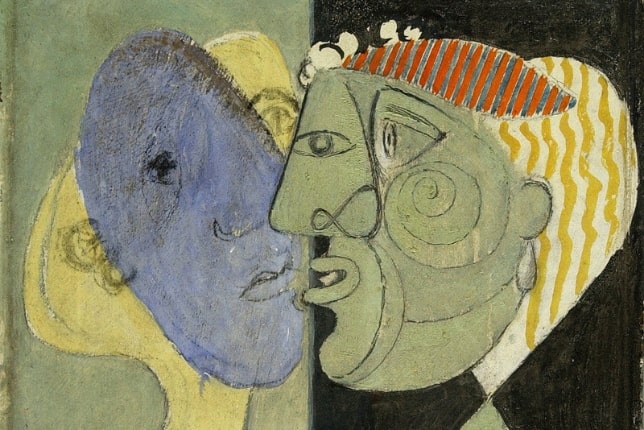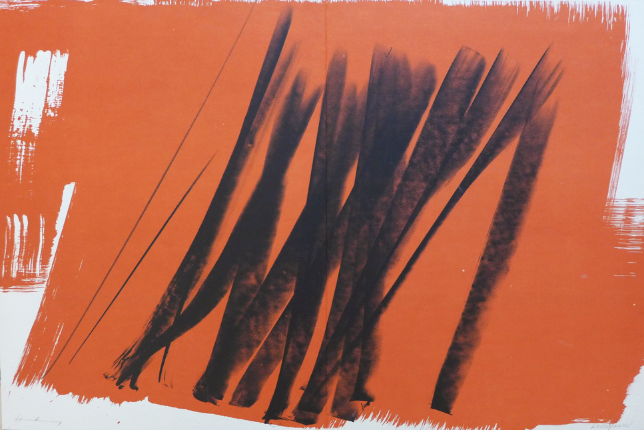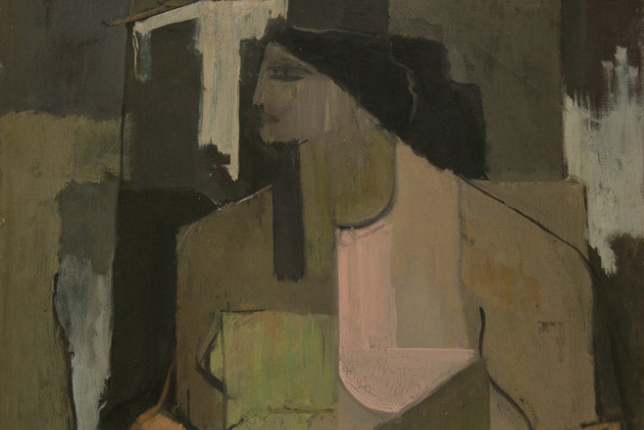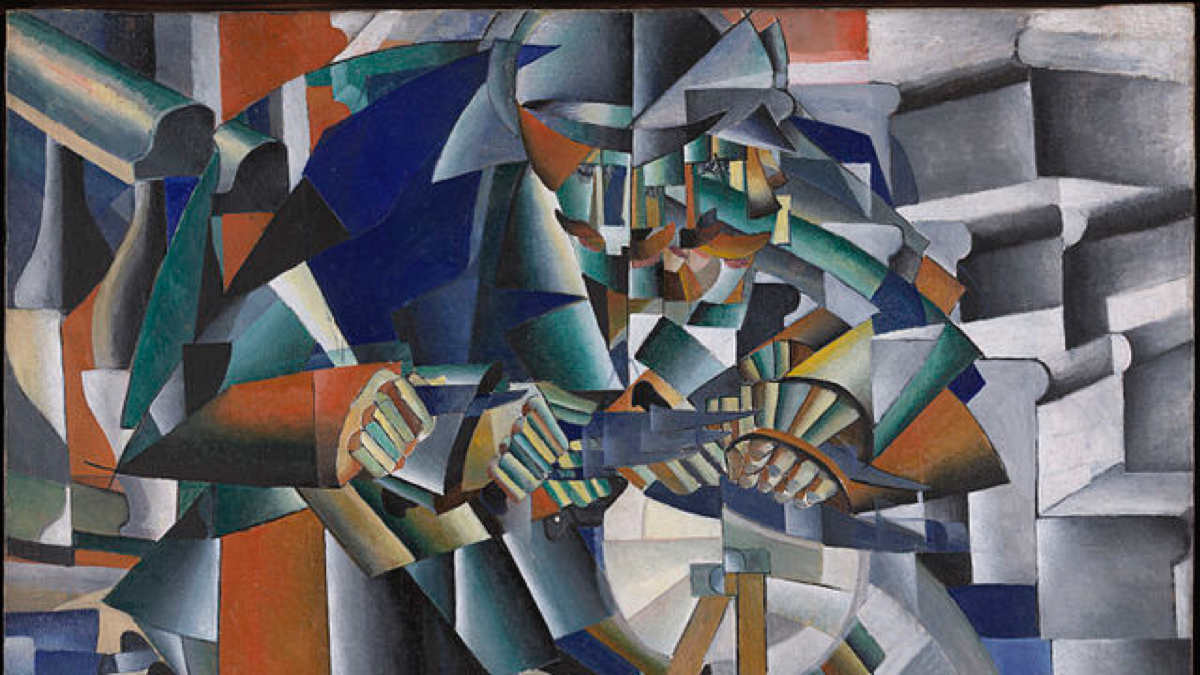
10 Things to Know About Hans Hartung

Born in Germany in 1904 – but later acquiring French citizenship – Hans Hartung is considered one of the fathers of abstract art, but also of tachisme. Full of dynamism and freedom, Hans Hartung’s artworks are driven by the desire to develop a new pictorial language.
Today, Artsper invites you to learn more about him and his works. Come and discover the man behind these wild and free paintings. You might be surprised…
1. He lost his leg during the War.

During the Second World War, Hartung was eager to fight against Germany, so he joined the French regular army. Due to his German nationality, he was be transferred to the Foreign Legion. In November 1944, an attack occurred in the city of Belfort which left him seriously injured. Due to this injury, his right leg had to be amputated. Hartung returned from the war traumatized, but also impatient to continue his pictorial work after 5 years of interruption. Upon his return, he was very concerned by his injuries, but also by the fact that other artists who did not go to fight, were therefore able to develop their careers and perfect their art whilst he had been fighting.
2. He made detailed preparatory drawings before producing each painting.

Untitled, Hans Hartung, 1934
When Hans Hartung arrived in Paris in the 1930s, he was struggling to make ends meet and had great difficulty in obtaining art supplies. One day his friend Jean Hélion, who was also a painter, gave him an advice that Hans would never forget. He advised him to always remain faithful to his sketches, and to accept his mistakes. Thus, from this period on, and until the 1960s, Hartung faithfully reproduced all of his sketches on canvas, through the use of a grid. This process allowed him to save on canvases, paint and brushes. As wild and dynamic as his paintings may appear, they were in fact meticulously and consciously prepared.
3. His wife was also an abstract painter.

Too often overshadowed by the work of her husband, Anna Eva Bergman was also an artist. Initially an illustrator and caricaturist, she made many visuals for magazines and even cooking books. It was during the 1950s, when she reconnected with Hans after their separation, that she started questioning her work. After a break, she, just like Hans, began to work on abstract painting. But unlike Hartung, she produced much quieter, serene works, large dark blue canvases, with gold and silver stars.
4. In Paris he met Mondrian, Miró and Calder.

© Fondation Hartung Bergman
After encountering many financial problems in Germany, Hans and his wife moved to Paris in 1935. They then lived in a studio at 19 rue Daguerre in Paris. During this period he worked with artists such as Mondrian, Miró and Calder. It is also during this period that he began to exhibit at the Pierre Loeb Gallery and participate in the Salon des Surindépendants each year.
5. He was also a sculptor.

By the late 1930s, Hartung’s financial situation was deteriorating very quickly and the artist had to move to a smaller apartment in Paris. Later on, his friend Henri Goetz took him under his roof. Then the sculptor Julio González welcomed him to his studio. Hans thus became friends with the sculptor and learned about three-dimensional art. Two abstract sculptures were created from this experiment, one of which was exhibited at the Salon des Surindépendants.
6. Alain Resnais made a film about him.

@ Fondation Hartung-Bergman
Despite the fact that he had not finished his film studies, the young Alain Resnais remained close to some of his professors at IDHEC (Institut des Hautes Études Cinématographiques), notably the art critic Madeleine Rousseau, who introduced him to Hans Hartung in 1947. Resnais thus shot a film on Hartung, 7 minutes long, in 16mm, black and white and for budget reasons, silent. The film screened in 1950 as part of the first monograph on Hartung’s work at Galerie La Hune, and depicted the artist in his Parisian studio, in the middle of his creative process.
7. He was passionate about photography.

© Fondation Hartung Bergman
Passionate about photography since his childhood, the painter said that he had the habit of taking pictures of everything, and that for him pictures were like a second memory. During a trip to Norway with Anna Eva Bergman, he took more than 1000 pictures of their journey beyond the North Cape. Finally, in 1977, the Cercle Noroit in Arras dedicated an exhibition to Hartung’s photographic production, for a celebration of his 73rd birthday.
8. He illustrated a collection of poems.

In the early 1960s, the poet and writer Jean Proal wrote a series of poems called Prière sur l’agonie or Farandole. One of Hans Hartung’s close friends, Proal sent him a few extracts, which the painter found deeply moving. This series of poems dealt with the absurdity of war and human violence, and more particularly of the Algerian war that had been raging for several years. It was only in 1971, two years after Proal’s death, that Hartung made about fifteen lithographs to illustrate the book of poetry.
9. He was obsessed with the golden ratio.

Towards the end of the 1920s, Hans Hartung became increasingly interested in French art, which he considered pure, healthy and refined. He said he couldn’t find these features in German art. He then became passionate about Braque and Picasso’s analytical cubism, and began to look for order in his work. Hartung saw the golden ratio as a way of organizing his composition, but also as a completely new mathematical, universal and timeless aesthetic. However in the mid-1930s, he violently rejected his mathematical research, calling it a shameful waste of time, and from then on he considered the golden ratio a sterile and limiting tool.
10. He rejected the teachings of the Bauhaus and Kandinsky.

In 1925, Hans Hartung attended a conference on abstract art by Kandinsky. During this event, the Russian painter presented his method and his new pictorial language. This conference comforted Hartung in his refusal to align himself with a predetermined school. He saw Kandinsky’s speech as nothing more than one more doctrine, and believed that he was on the right path regarding his art and his pictorial research. In the same way, he categorically refused to enter the Bauhaus, seeing its teaching as too oriented towards the applied arts and architecture.

About Artsper
Founded in 2013, Artsper is an online marketplace for contemporary art. Partnering with 1,800 professional art galleries around the world, it makes discovering and acquiring art accessible to all.
Learn more













